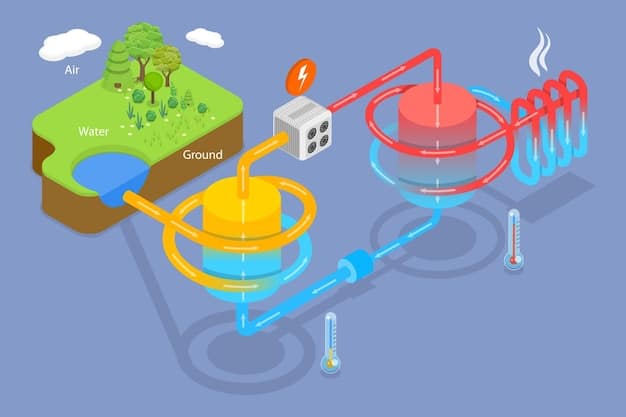Geothermal Energy Advancements: New Extraction Techniques in 2025

The newest advancements in geothermal energy extraction techniques include Enhanced Geothermal Systems (EGS), closed-loop systems, and advanced drilling technologies, all aimed at improving efficiency, sustainability, and accessibility of this renewable energy source.
The quest for sustainable and renewable energy sources has led to significant innovations in geothermal energy extraction. But what are the newest advancements in geothermal energy extraction techniques? This article explores the cutting-edge technologies transforming how we harness the Earth’s internal heat, making geothermal energy more efficient, accessible, and environmentally friendly.
Understanding Enhanced Geothermal Systems (EGS)
Enhanced Geothermal Systems (EGS) represent a significant leap forward in geothermal energy extraction. Unlike traditional geothermal systems that rely on naturally occurring hydrothermal resources, EGS creates artificial reservoirs deep underground, unlocking vast amounts of previously inaccessible geothermal energy.
This innovative approach involves injecting high-pressure water into hot, dry rocks thousands of feet below the surface. The pressurized water fractures the rock, creating permeability and allowing the water to circulate and heat up. The heated water is then pumped back to the surface to generate electricity.
The Process of EGS
EGS is a complex process that requires careful planning and execution. Here’s a breakdown of the key steps:
- Site Selection: Identifying locations with high geothermal gradients and suitable rock formations.
- Drilling: Drilling deep wells into the hot, dry rock formations.
- Hydraulic Fracturing: Injecting high-pressure water to create fractures within the rock.
- Reservoir Creation: Establishing a network of interconnected fractures to allow water circulation.
- Energy Extraction: Pumping heated water to the surface to generate electricity.

EGS has the potential to significantly expand the availability of geothermal energy, as it can be implemented in areas without naturally occurring geothermal reservoirs. This makes geothermal energy a viable option for a much wider range of locations, contributing to a more diversified and sustainable energy mix.
Closed-Loop Geothermal Systems
Closed-loop geothermal systems are another groundbreaking advancement in geothermal energy extraction. These systems offer several advantages over traditional geothermal methods, including enhanced efficiency, reduced environmental impact, and greater operational flexibility.
In a closed-loop system, a working fluid (often water or a specialized refrigerant) is circulated through a network of pipes buried deep underground. The fluid absorbs heat from the surrounding earth and is then brought back to the surface to generate electricity or provide direct heating.
Benefits of Closed-Loop Systems
Closed-loop geothermal systems offer numerous benefits, making them an attractive option for geothermal energy development:
- Enhanced Efficiency: By optimizing the circulation of the working fluid, closed-loop systems can achieve higher energy extraction rates.
- Reduced Environmental Impact: These systems minimize water usage and eliminate the risk of groundwater contamination.
- Greater Operational Flexibility: Closed-loop systems can be adapted to a wide range of geological conditions and energy demands.
One of the key advantages of closed-loop systems is their ability to operate without directly extracting groundwater. This is particularly important in arid and semi-arid regions where water resources are scarce. By minimizing water usage, closed-loop systems help to conserve precious water supplies and reduce the environmental impact of geothermal energy production. Furthermore, the risk of induced seismicity is minimal due to the absence of fracking.
Advanced Drilling Technologies
The efficiency and cost-effectiveness of geothermal energy extraction are heavily dependent on drilling technologies. Recent advancements in drilling techniques have made it possible to reach greater depths, penetrate harder rock formations, and reduce drilling costs, thereby unlocking new opportunities for geothermal energy development.
One of the most promising advancements is the development of advanced drilling materials and methods that can withstand the extreme temperatures and pressures encountered deep underground. These technologies include high-temperature drilling fluids, advanced drill bits, and automated drilling systems.
Innovations in Drilling
Several innovations in drilling technology are driving the advancement of geothermal energy extraction:
- High-Temperature Drilling Fluids: Specially formulated fluids that maintain their stability and lubricating properties at high temperatures.
- Advanced Drill Bits: Durable and efficient drill bits that can penetrate hard rock formations with greater speed and precision.
- Automated Drilling Systems: Robotic drilling systems that can operate autonomously, reducing the need for human intervention and improving drilling efficiency.
These advanced drilling technologies are enabling geothermal developers to access deeper and hotter geothermal resources, which in turn increases the amount of electricity that can be generated from a geothermal power plant. Additionally, automated drilling systems can significantly reduce drilling costs, making geothermal energy more competitive with other renewable energy sources.
Geothermal Heat Pumps (GHPs)
Geothermal Heat Pumps (GHPs) are an efficient and environmentally friendly way to heat and cool buildings. These systems utilize the Earth’s constant temperature to provide heating in the winter and cooling in the summer, offering significant energy savings compared to traditional HVAC systems.
GHPs work by circulating a refrigerant through a network of underground pipes. In the winter, the refrigerant absorbs heat from the ground and transfers it to the building. In the summer, the process is reversed, with the refrigerant absorbing heat from the building and transferring it to the ground.

GHPs are becoming increasingly popular as homeowners and businesses seek ways to reduce their carbon footprint and lower their energy bills. Government incentives and rebates are also helping to drive the adoption of GHPs, making them a more affordable and attractive option.
Types of GHPs
There are several types of GHPs, each with its own advantages and disadvantages:
- Vertical Loop Systems: Pipes are buried vertically in deep boreholes.
- Horizontal Loop Systems: Pipes are buried horizontally in shallow trenches.
- Pond/Lake Systems: Pipes are submerged in a nearby body of water.
The choice of GHP system depends on a variety of factors, including the size of the property, the local climate, and the availability of water resources. However, regardless of the type of system, GHPs offer significant energy savings and environmental benefits.
Materials Science Advancements
Advancements in materials science are crucial for improving the performance and durability of geothermal energy extraction systems. The extreme temperatures, pressures, and corrosive environments encountered deep underground require materials that can withstand harsh conditions and maintain their structural integrity.
Researchers are developing new alloys, composites, and coatings that are specifically designed for geothermal applications. These materials offer improved resistance to corrosion, erosion, and thermal stress, extending the lifespan of geothermal equipment and reducing maintenance costs.
These advancements in materials science are enabling geothermal developers to build more reliable and efficient geothermal power plants, further enhancing the competitiveness of geothermal energy.
Key Material Innovations
Several key material innovations are contributing to the advancement of geothermal energy extraction:
- High-Temperature Alloys: Alloys that maintain their strength and corrosion resistance at high temperatures.
- Composite Materials: Lightweight and durable materials that offer excellent resistance to chemical attack.
- Protective Coatings: Coatings that protect geothermal equipment from corrosion and erosion.
Digital Technologies and Data Analytics
Digital technologies and data analytics are playing an increasingly important role in geothermal energy extraction. Advanced sensors, data acquisition systems, and analytical tools are being used to monitor the performance of geothermal systems, optimize energy production, and predict potential problems.
By analyzing real-time data from geothermal wells and power plants, operators can identify opportunities to improve efficiency, reduce downtime, and extend the lifespan of equipment. Digital twins, which are virtual replicas of physical geothermal systems, are also being used to simulate different operating scenarios and optimize system performance.
The use of digital technologies and data analytics is helping to transform geothermal energy from a traditional, reactive industry to a modern, data-driven one. These technologies are enabling geothermal operators to make better decisions, improve system performance, and reduce costs.
Data-Driven Optimization
Data-driven optimization is revolutionizing geothermal energy extraction through:
- Predictive Maintenance: Using data analytics to predict equipment failures and schedule maintenance proactively.
- Real-Time Monitoring: Monitoring the performance of geothermal systems in real-time to identify and address potential problems.
- Performance Optimization: Optimizing system performance based on data analysis to maximize energy production and efficiency.
| Key Point | Brief Description |
|---|---|
| 💡 Enhanced Geothermal Systems | Creates artificial reservoirs using hydraulic fracturing for wider geothermal access. |
| 🔄 Closed-Loop Systems | Circulates working fluid in a closed system, reducing water usage and environmental impact. |
| 🛠️ Advanced Drilling Tech | Uses high-temp fluids and automated systems to reach deeper, hotter resources efficiently. |
| 🏠 Geothermal Heat Pumps | Uses Earth’s temperature for efficient heating/cooling, reducing energy bills and emissions. |
FAQ
▼
EGS allows geothermal energy extraction in locations without natural hydrothermal resources, significantly expanding geothermal’s potential. It helps to create artificial reservoirs deep underground.
▼
Closed-loop systems minimize water usage and eliminate the risk of groundwater contamination by circulating a working fluid within a closed network, making them eco-friendly.
▼
Advanced drilling technologies enable access to deeper and hotter geothermal resources, increasing electricity generation and reducing costs through the use of innovative materials.
▼
GHPs use the Earth’s constant temperature to provide heating and cooling by circulating a refrigerant through underground pipes, offering energy savings and lowering carbon footprints.
▼
Digital technologies and data analytics allow real-time monitoring, predictive maintenance, and performance optimization, helping improve decision-making and reduce costs for geothermal systems.
Conclusion
The newest advancements in geothermal energy extraction techniques are revolutionizing the way we harness the Earth’s internal heat. From Enhanced Geothermal Systems (EGS) and closed-loop systems to advanced drilling technologies and digital data analytics, these innovations are making geothermal energy more efficient, sustainable, and accessible. As we continue to invest in and develop these technologies, geothermal energy has the potential to play a significant role in meeting our growing energy demands while reducing our reliance on fossil fuels.





